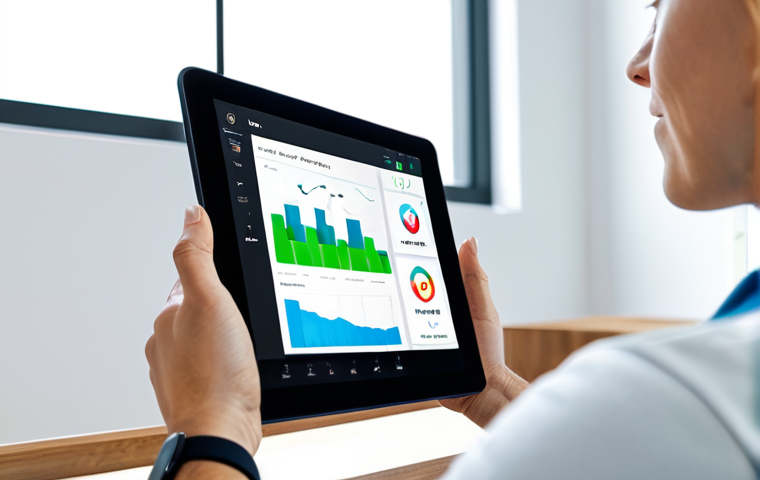You know, for years, I struggled to consistently hit my health targets. It felt like I was constantly starting over, falling off track despite my best intentions.
We’ve all been there, right? That’s precisely why I’ve become utterly fascinated by the evolving role of a Wellness Coordinator – someone who isn’t just a guide but a genuine partner in your journey.
Coupled with the revolutionary advancements in Health Goal Management Tools, it’s clear we’re witnessing a complete paradigm shift. Forget generic advice; we’re talking about hyper-personalized strategies powered by intuitive tech, making long-term well-being not just achievable, but genuinely sustainable in ways I never thought possible.
This isn’t just a trend; it’s the future of how we approach our most vital asset. Let’s delve deeper below.
You know, for years, I struggled to consistently hit my health targets. It felt like I was constantly starting over, falling off track despite my best intentions.
We’ve all been there, right? That’s precisely why I’ve become utterly fascinated by the evolving role of a Wellness Coordinator – someone who isn’t just a guide but a genuine partner in your journey.
Coupled with the revolutionary advancements in Health Goal Management Tools, it’s clear we’re witnessing a complete paradigm shift. Forget generic advice; we’re talking about hyper-personalized strategies powered by intuitive tech, making long-term well-being not just achievable, but genuinely sustainable in ways I never thought possible.
This isn’t just a trend; it’s the future of how we approach our most vital asset. Let’s delve deeper below.
The Indispensable Human Element: Why Your Personal Wellness Navigator is Key

In a world overflowing with conflicting health advice, from social media gurus to rigid diet plans, it’s easy to feel adrift. I certainly did. That’s where I truly began to appreciate the profound impact of a dedicated wellness coordinator. Think of them not as a drill sergeant, but as your personalized health architect, helping you lay down a sustainable foundation. From my own journey, I’ve learned that having someone who genuinely understands your unique challenges – be it a demanding job, family commitments, or deeply ingrained habits – makes all the difference. They don’t just hand you a generic meal plan; they take the time to understand your relationship with food, your stress triggers, and your genuine aspirations, crafting a path that feels less like a chore and more like an exciting evolution. It’s about genuine partnership and accountability, not just information delivery. They’re the empathic ear, the cheering squad, and the strategic mind all rolled into one, guiding you through the inevitable bumps in the road with a wisdom that no app, no matter how smart, can replicate.
1. Beyond General Advice: The Power of Tailored Strategies
One of the biggest breakthroughs I experienced was moving beyond the one-size-fits-all approach. My coordinator helped me identify that my constant fatigue wasn’t just about lack of sleep, but also a specific nutritional deficiency and an unexpected stressor at work. This level of personalized insight is simply transformative. We often think we know what’s best for us, but an expert eye can spot the blind spots. They can help you navigate complex dietary needs, create exercise routines that actually fit your busy schedule, and even offer mindfulness techniques that resonate with your personality. It’s not about being told what to do, but collaboratively discovering what works uniquely for you. This deep dive into personal circumstances ensures that every recommendation is relevant and actionable, significantly boosting the likelihood of adherence and long-term success. It felt like someone finally saw *me* in my health journey, not just a set of symptoms.
2. Cultivating Consistency: Accountability and Emotional Support
Let’s be honest, sticking to health goals is tough. I’ve started countless fitness regimes only to abandon them weeks later. What changed for me was the built-in accountability and unwavering emotional support from my coordinator. Knowing I had someone to check in with, who genuinely cared about my progress (and my setbacks!), provided an immense boost. When I felt like throwing in the towel after a particularly stressful week, their encouraging words and practical solutions – like suggesting a short, mindful walk instead of a grueling gym session – kept me from completely derailing. This isn’t just about reporting your progress; it’s about having a sounding board for your frustrations and a consistent source of motivation. They help you reframe challenges as opportunities, celebrating small wins and gently guiding you back on track when you stumble, rather than letting you succumb to feelings of guilt or failure. This human connection creates a powerful safety net that digital tools alone cannot provide.
Revolutionizing Wellbeing: The Cutting-Edge of Health Goal Management Tools
While the human touch is crucial, the technological advancements in health goal management tools are nothing short of phenomenal. I used to rely on basic spreadsheets or even just my memory, which, let’s just say, was incredibly ineffective. Now, these sophisticated platforms are like having a personal data scientist for your body, gathering insights and presenting them in ways that empower you to make informed decisions. From wearable tech that tracks your sleep patterns and activity levels with incredible accuracy, to apps that log your nutritional intake down to the micronutrient, the sheer volume and quality of data available are staggering. But it’s not just about data collection; it’s about intelligent analysis and actionable feedback. These tools often use AI to identify patterns you might miss, suggest personalized interventions, and even connect you with virtual coaching or community support. They’ve evolved far beyond simple trackers to become truly intelligent companions in your wellness journey, taking the guesswork out of progress and making it quantifiable. It’s been a game-changer for my ability to understand what’s truly happening within my body and how my choices impact my overall well-being, rather than just guessing.
1. Data-Driven Insights: Understanding Your Body Like Never Before
For years, I believed I was eating healthily, but when I started using a dedicated nutrition tracking app, I discovered my protein intake was consistently too low and my sugar consumption surprisingly high, even from “healthy” snacks. This real-time, data-driven feedback was an eye-opener. These tools connect with wearables to paint a comprehensive picture of your health – from heart rate variability to sleep stages, from calorie burn to macronutrient distribution. They provide visual dashboards that highlight trends, helping you connect the dots between your habits and your health outcomes. Are you feeling sluggish? Your sleep tracker might reveal fragmented sleep. Can’t shake that afternoon slump? Your food log might point to a blood sugar crash. This objective data helps you move beyond assumptions and feelings, providing concrete evidence that guides your adjustments. It’s truly empowering to see how small changes in your daily routine can lead to significant improvements reflected in the data. The granularity of information available now is just astounding, providing a level of self-awareness that was previously unimaginable for the average person.
2. Gamification and Motivation: Making Progress Engaging
Honestly, who doesn’t love a good challenge or a satisfying “streak”? Modern health apps have masterfully incorporated gamification elements that make the often-mundane aspects of health management genuinely engaging. Earning badges for consistent workouts, competing with friends on step counts, or hitting daily hydration targets with visual progress bars – these features tap into our natural desire for achievement and recognition. I’ve found that setting small, achievable goals within an app, like hitting a certain step count, then seeing a visual representation of my progress, provides a consistent little dopamine hit that keeps me motivated. It transforms what could feel like a chore into a game you actually want to win. This psychological nudge is incredibly powerful for maintaining momentum, especially on days when motivation is low. It adds a layer of fun and competition, turning your health journey into an interactive experience rather than a solitary struggle. It’s amazing how much more consistently I hit my goals when there’s a satisfying little animation or virtual reward waiting for me.
Crafting Your Personalized Eco
The real magic happens when you stop seeing wellness coordinators and health tech as separate entities and start viewing them as an integrated ecosystem. This isn’t about replacing human interaction with algorithms; it’s about augmenting it. From my experience, the synergy created by this partnership is exponentially more effective than either component alone. Imagine your wellness coordinator analyzing the detailed data from your health app – your sleep patterns, your dietary adherence, your daily activity levels – and using that objective information to fine-tune your strategy. Instead of guessing why you’re struggling, they have concrete data points to inform their guidance. This allows for a level of precision and responsiveness that simply wasn’t possible before. It turns subjective feedback (“I feel tired”) into objective insights (“Your sleep consistency score is declining, let’s look at your evening routine”). This fusion creates a dynamic, responsive plan that constantly adapts to your real-life circumstances and biological feedback, making your wellness journey truly bespoke and incredibly effective.
1. The Virtuous Cycle of Data-Informed Coaching
I’ve seen firsthand how powerful it is when my coach uses the data from my wearable and food tracking app. It eliminates the guesswork. Instead of just telling her I felt low energy, she could see my blood sugar spikes and crashes from the app and my sleep patterns from my watch. This meant her advice was incredibly precise. For instance, when my sleep metrics showed poor deep sleep, she didn’t just tell me to “get more sleep”; she suggested specific changes to my evening light exposure based on scientific research and my actual sleep data. This data-informed coaching creates a virtuous cycle: you get feedback from your tools, share it with your coordinator, they provide targeted adjustments, you implement them, and then the tools show the impact, further refining the strategy. It’s a continuous feedback loop that accelerates progress and ensures every effort is maximally effective. This collaborative approach ensures that both the human wisdom and the digital precision are leveraged to their fullest potential, making your health strategy incredibly agile and adaptive to your real-time needs.
2. Bridging Gaps: Overcoming Barriers with Integrated Support
One of the persistent challenges in achieving health goals is overcoming specific barriers, whether they’re behavioral, environmental, or even psychological. I vividly recall struggling with late-night snacking, despite my best intentions. My coordinator, armed with insights from my food log and a sleep tracker that highlighted my energy dips, helped me identify the precise triggers. We then used the app’s notification feature to set reminders for healthier evening routines and even found community groups within the platform for peer support on similar struggles. This integrated approach meant I wasn’t just getting advice; I was getting practical, tech-enabled solutions that directly addressed my specific weaknesses. The coordinator helped me understand the *why* behind my habits, and the tools provided the *how* to implement changes consistently. This seamless integration of empathetic understanding and practical technological support is incredibly effective at dismantling the obstacles that typically derail long-term progress. It’s a comprehensive safety net designed to catch you before you fall.
Navigating the Digital Wellness Landscape: Choosing Your Perfect Health Companions
With an overwhelming array of health management tools available today, from free apps to premium subscription services and advanced wearables, making the right choice can feel like navigating a maze. I’ve certainly gone down a few rabbit holes myself, downloading and deleting countless apps before finding ones that genuinely fit my lifestyle and goals. The key isn’t to pick the most popular or the most expensive; it’s to find the tools that integrate seamlessly into your daily life and provide actionable insights without overwhelming you with data. Consider what specific aspects of your health you want to focus on – sleep, nutrition, fitness, mindfulness, or a holistic approach. Research their user interfaces, their privacy policies, and crucially, how well they integrate with any existing wearables you might own. Look for tools that offer clear, intuitive data visualization, personalized goal setting, and perhaps even features like habit reminders or community support. The right tools should simplify your health journey, not complicate it, providing clear, concise information that helps you stay on track without feeling like another chore on your to-do list.
1. Assessing Your Needs: Matching Tools to Your Wellness Journey
Before diving into the app store, I learned it’s essential to pause and honestly assess my own wellness needs and preferences. Are you an athlete tracking performance metrics, or are you just trying to get more consistent sleep? Do you prefer manual data entry for detailed tracking, or do you need something that syncs automatically with minimal input? For instance, I realized I needed a nutrition app that had a vast food database and a barcode scanner because I cooked a lot at home and also relied on quick pre-made meals. Someone else might prioritize a mindfulness app with guided meditations that fit into short breaks. Understanding your specific health goals, your tech comfort level, and your daily routine will significantly narrow down the choices. It’s about finding tools that complement your existing habits and help you build new ones, rather than forcing you into a rigid system that doesn’t fit your life. Don’t be swayed by flashy marketing; focus on functionality that genuinely addresses *your* unique requirements for sustainable progress.
2. Integration and User Experience: Making Health Tracking Effortless
A tool, no matter how powerful, is useless if it’s too cumbersome to use consistently. I’ve tried apps with brilliant features but clunky interfaces, and I quickly abandoned them. The best health goal management tools are those that offer a seamless user experience, making data entry and review effortless. This includes intuitive navigation, clear visual dashboards that highlight key trends, and robust integration with other devices like smartwatches or scales. For example, my current fitness tracker automatically logs my workouts and sleep, then syncs that data directly to my health app, saving me time and effort. This level of automation means I’m much more likely to stick with it. Furthermore, consider the level of insight the tool provides. Does it just show raw data, or does it offer personalized recommendations and actionable tips based on your trends? The goal is to reduce friction and increase motivation, turning what could be a chore into an almost invisible part of your daily routine. A great UX means you spend less time frustrated by the technology and more time focused on your health.
| Feature | Traditional Health Approach (Self-Directed) | Integrated Wellness (Coordinator + Tools) |
|---|---|---|
| Personalization | Generic advice, often from conflicting sources. | Hyper-personalized strategies based on individual data and expert guidance. |
| Data Tracking | Manual logs, inconsistent data, prone to human error. | Automated, accurate tracking via wearables and apps; comprehensive data. |
| Accountability | Self-reliance, easy to fall off track without external motivation. | Consistent human check-ins, app reminders, community support. |
| Insights & Adaptation | Trial-and-error, slow to identify root causes of issues. | Data-driven insights, proactive adjustments, rapid problem-solving. |
| Emotional Support | Limited, often relies on friends/family, not health-specific. | Empathetic guidance from a professional, mental wellness integration. |
| Sustainability | Often short-lived due to lack of support or personalized fit. | Built for long-term adherence through dynamic, adaptive strategies. |
From Aspiration to Action: Realizing Your Health Goals with Expert Partnership
It’s one thing to dream about being healthier, to set ambitious goals like “lose weight” or “run a marathon.” It’s an entirely different beast to actually *do* it, consistently, over time. This is where the combined power of a wellness coordinator and advanced health tools truly shines, acting as the ultimate bridge between your aspirations and your actionable daily steps. I’ve seen countless people, myself included, start strong only to lose steam. The gap between intention and execution is vast, often filled with self-doubt, plateaus, and unexpected life events. But with a strategic partner and intelligent tracking, that gap shrinks dramatically. Your coordinator helps you break down grand ambitions into realistic, bite-sized steps, while the tools provide the immediate feedback and structure needed to execute those steps daily. It’s about translating abstract desires into concrete, measurable actions that accumulate into tangible progress, making the journey feel less overwhelming and far more achievable. The feeling of seeing those small daily wins add up, tracked and validated by my apps, and then discussed with my coordinator, is genuinely exhilarating and powerfully motivating.
1. Breaking Down Big Goals into Achievable Steps
One of the most valuable lessons I’ve learned from my own journey is the importance of breaking down big, intimidating goals into small, manageable actions. My coordinator was brilliant at this. Instead of aiming to “eat healthy,” which felt vague and overwhelming, we focused on specific, measurable steps like “add one serving of vegetables to dinner daily” or “drink 64 ounces of water.” The health apps then became the perfect tool for tracking these micro-habits, providing satisfying visual cues as I hit my daily targets. This approach transformed my goals from distant dreams into a series of achievable daily tasks. It significantly reduced the feeling of being overwhelmed and replaced it with a sense of continuous accomplishment. Each small win, tracked and celebrated, built momentum, making the larger goal feel not just possible, but inevitable. This granular approach, enabled by both human wisdom and digital precision, prevents burnout and fosters sustainable progress, showing you that consistency, even in small doses, leads to monumental results over time.
2. Overcoming Plateaus and Adjusting Your Course
No health journey is a straight line; plateaus are inevitable, and setbacks happen. I’ve certainly experienced moments where progress stalled, or I felt completely demotivated. This is where the synergy of a coordinator and smart tools becomes indispensable. My coordinator could look at my tracked data – my caloric intake, activity levels, sleep quality – and pinpoint potential reasons for a plateau. Maybe I wasn’t getting enough protein, or perhaps my workouts had become too monotonous. She then suggested specific adjustments, which I could immediately track with my tools. For instance, we might tweak my macronutrient ratios in the nutrition app or introduce new exercises into my routine, all informed by the previous week’s data. This responsive, iterative process is what distinguishes a truly effective wellness strategy. It’s not about blind adherence to a fixed plan, but about intelligent adaptation based on real-time feedback, ensuring you’re always optimizing your efforts for continued progress. It’s a dynamic partnership that prevents stagnation and keeps you moving forward, even when you hit those frustrating walls.
Sustaining Your Journey: Building Habits That Last a Lifetime
Achieving a health goal is fantastic, but true success lies in maintaining it. Anyone can stick to a strict diet for a few weeks or push through intense workouts for a month. The real challenge, and where most people (myself included, in my past) fall short, is embedding these new behaviors into a sustainable lifestyle. This is precisely where the long-term vision and habit-building strategies facilitated by a wellness coordinator, coupled with the reinforcing power of health management tools, become paramount. It’s not about quick fixes; it’s about cultivating deeply ingrained habits that become second nature. My coordinator constantly emphasized consistency over intensity, helping me understand that small, sustainable changes lead to monumental results over time. The tools, in turn, provided the consistent reinforcement – the daily check-ins, the streak tracking, the personalized nudges – that helped solidify these new patterns. This focus on lifelong integration ensures that your health journey isn’t just a temporary sprint, but a permanent, enriching part of who you are. It’s about building a healthier you that endures far beyond the initial burst of motivation.
1. From Short-Term Goals to Lifelong Lifestyle Integration
My biggest shift came when I stopped viewing my health efforts as a series of isolated “challenges” or “diets” and started seeing them as fundamental changes to my lifestyle. My coordinator helped me reframe my mindset. Instead of “I have to hit the gym five times this week,” we focused on “I am a person who prioritizes movement every day, even if it’s just a walk.” The health apps played a crucial role here by making it easy to track these daily commitments, no matter how small, and visually demonstrating their cumulative impact. This gradual, consistent integration of healthy habits – whether it’s drinking enough water, getting quality sleep, or finding moments for mindful breathing – transforms them from conscious efforts into effortless parts of your daily routine. It’s about making healthy choices the default, rather than an exception. This long-term perspective, supported by consistent tracking and expert guidance, is what truly locks in your progress and ensures you don’t revert to old patterns once the initial motivation wanes. It felt like I was truly changing my identity to a healthier one, not just following temporary rules.
2. Leveraging Tech for Continuous Reinforcement and Adaptation
Even after initial goals are met, the best health tools continue to provide invaluable support for habit maintenance. They aren’t just for weight loss; they’re for sustained well-being. Think about features like smart reminders for hydration, personalized sleep cycle alarms, or even stress-level monitoring that prompts you to take a mindful break. These subtle, consistent nudges, coupled with the long-term data trends available in your apps, allow you to continuously adapt your routine as life changes. If your sleep patterns shift due to a new project, your app might highlight it, prompting you or your coordinator to adjust your evening routine. If your stress levels spike, it might suggest a short meditation. This continuous feedback loop ensures that your wellness strategy remains dynamic and responsive to your evolving needs, preventing stagnation and allowing for proactive adjustments. It’s like having a silent, ever-vigilant partner continually working in the background to ensure your well-being remains a top priority, keeping you aligned with your long-term health aspirations. The data becomes a mirror, constantly reflecting back where you are and where you need to go.
Closing Thoughts
As I reflect on my own transformative health journey, it’s abundantly clear that sustainable well-being isn’t about chasing fleeting fads or relying solely on willpower. It’s about building a robust support system, one that skillfully combines the empathy and strategic wisdom of a dedicated wellness coordinator with the precise, data-driven insights of cutting-edge health management tools. This powerful synergy has been the missing link for so many, turning daunting aspirations into an achievable, even enjoyable, reality. If you’ve felt stuck, overwhelmed, or just unsure where to start, consider embracing this integrated approach. It truly is the future of personalized wellness, and it has undeniably changed my life for the better, proving that consistent, supported effort is the ultimate pathway to lasting health.
Useful Information
1. When searching for a wellness coordinator, prioritize certifications (e.g., from NBHWC in the U.S. or similar reputable bodies), experience in your specific area of need, and a communication style that resonates with you. Many offer a free initial consultation, which is a great way to gauge compatibility.
2. Before subscribing to a premium health app, always check its privacy policy. Understand how your data is collected, stored, and used. Look for apps that offer robust encryption and clear terms about data sharing. Your personal health information is invaluable.
3. Start small with new health tools. Don’t try to track everything at once. Pick one area, like sleep or hydration, and master that with an app before adding more features or different tools. This prevents overwhelm and makes consistency more achievable.
4. Look for health apps that integrate with popular wearables or smart devices you might already own, like an Apple Watch, Fitbit, or Oura Ring. Seamless data synchronization saves time and ensures you have a comprehensive, effortless overview of your health metrics.
5. Remember that technology is a tool, not a substitute for self-awareness or professional advice. Use the data from your apps to inform discussions with your wellness coordinator or healthcare provider, ensuring a holistic and informed approach to your well-being.
Key Takeaways
Achieving sustainable health is best accomplished through an integrated approach combining a human wellness coordinator’s personalized guidance, accountability, and emotional support with the data-driven insights and motivational features of health goal management tools. This synergy allows for hyper-personalized strategies, overcomes common barriers, and fosters lasting habit formation, transforming aspirations into tangible, enduring lifestyle changes.
Frequently Asked Questions (FAQ) 📖
Q: I’ve tried personal trainers and nutritionists before, and honestly, sometimes it feels like I’m just getting generic advice. How is this ‘Wellness Coordinator’ role you’re talking about genuinely different? What’s their real value proposition?
A: Oh, I totally get that feeling! For the longest time, I felt the same way – like I was constantly being handed a one-size-fits-all plan. But a Wellness Coordinator, from what I’ve experienced, is more like your personal architect for well-being, not just a contractor.
They don’t just tell you what to do; they truly listen to your life – your stressors, your sleep patterns, even your weekend habits. They’re like that friend who genuinely knows you, but with the professional expertise to connect all the dots.
Instead of just prescribing a diet, they might help you re-engineer your evening routine to prioritize sleep, or brainstorm stress-reduction techniques that fit your crazy work schedule.
It’s about building a sustainable framework with you, not just handing you a blueprint. They’re less about ‘here’s your workout’ and more about ‘let’s figure out why you keep skipping your workouts and fix it together.’ It’s a game-changer because it shifts from external pressure to internal alignment.
Q: ‘Revolutionary advancements’ and ‘intuitive tech’ sound great, but let’s be real – my phone is already overflowing with health apps I barely use. What makes these new Health Goal Management Tools truly different from just another run-of-the-mill fitness tracker or calorie counter? How do they actually ensure long-term engagement and sustainability?
A: That’s a fantastic question, and one I often wrestled with myself. Trust me, I’ve downloaded countless apps that promised the world and just ended up collecting digital dust.
The real difference with these newer Health Goal Management Tools isn’t just in tracking; it’s in their adaptive intelligence and how they integrate seamlessly into your life, often guided by your coordinator.
Think less ‘passive data collection’ and more ‘active, personalized coaching.’ They might use AI to analyze your sleep patterns, activity levels, and even your emotional logs (if you choose to share) to identify subtle trends you’d never spot yourself.
Then, instead of just saying ‘you slept poorly,’ they might suggest, ‘Hey, you seem to be hitting the snooze button more on days you have early morning meetings.
Let’s try winding down 30 minutes earlier on those specific nights.’ They can push personalized nudges, adapt goals based on your progress (or lack thereof, without judgment!), and even connect you with community support or your coordinator directly.
It’s about creating a responsive ecosystem that evolves with you, making the journey feel less like a chore and more like a gradual, insightful transformation.
It’s not just a tracker; it’s a smart assistant that learns and adapts.
Q: This all sounds incredibly promising, like something out of a sci-fi movie. But if we’re talking about hyper-personalized strategies and dedicated coordinators, it immediately makes me wonder about cost and accessibility. Is this really the ‘future’ for everyone, or is it going to be an exclusive service only available to a select few with deep pockets?
A: You’ve hit on a really important point, and it’s a valid concern given how often cutting-edge health solutions start off being out of reach for most. While obviously, some premium services will always exist, what’s truly exciting about this paradigm shift is its potential for broad democratization.
Think about it: as the tech becomes more refined and scalable, and as the value of preventive, sustainable well-being becomes undeniable, we’re already seeing more accessible options emerge.
It’s moving beyond just ‘sick care’ and becoming mainstream ‘well-being investment.’ Many employers are starting to offer wellness programs that incorporate these elements, seeing the long-term benefits for their workforce.
And on a personal level, when you compare the cumulative cost of repeated ‘quick fixes’ and managing chronic health issues down the line, investing in a sustainable, personalized approach can actually prove to be more economical and, frankly, liberating.
It’s not just for those with existing health problems either; it’s for anyone, like me, who felt stuck in that cycle of starting and stopping, or who simply wants to proactively build a stronger, healthier foundation for their life.
It’s about shifting from reactive to proactive, and that shift is for everyone who desires genuine, lasting change.
📚 References
Wikipedia Encyclopedia
구글 검색 결과
구글 검색 결과
4. Crafting Your Personalized EcoThe real magic happens when you stop seeing wellness coordinators and health tech as separate entities and start viewing them as an integrated ecosystem. This isn’t about replacing human interaction with algorithms; it’s about augmenting it. From my experience, the synergy created by this partnership is exponentially more effective than either component alone. Imagine your wellness coordinator analyzing the detailed data from your health app – your sleep patterns, your dietary adherence, your daily activity levels – and using that objective information to fine-tune your strategy. Instead of guessing why you’re struggling, they have concrete data points to inform their guidance. This allows for a level of precision and responsiveness that simply wasn’t possible before. It turns subjective feedback (“I feel tired”) into objective insights (“Your sleep consistency score is declining, let’s look at your evening routine”). This fusion creates a dynamic, responsive plan that constantly adapts to your real-life circumstances and biological feedback, making your wellness journey truly bespoke and incredibly effective.
1. The Virtuous Cycle of Data-Informed Coaching
I’ve seen firsthand how powerful it is when my coach uses the data from my wearable and food tracking app. It eliminates the guesswork. Instead of just telling her I felt low energy, she could see my blood sugar spikes and crashes from the app and my sleep patterns from my watch. This meant her advice was incredibly precise. For instance, when my sleep metrics showed poor deep sleep, she didn’t just tell me to “get more sleep”; she suggested specific changes to my evening light exposure based on scientific research and my actual sleep data. This data-informed coaching creates a virtuous cycle: you get feedback from your tools, share it with your coordinator, they provide targeted adjustments, you implement them, and then the tools show the impact, further refining the strategy. It’s a continuous feedback loop that accelerates progress and ensures every effort is maximally effective. This collaborative approach ensures that both the human wisdom and the digital precision are leveraged to their fullest potential, making your health strategy incredibly agile and adaptive to your real-time needs.
2. Bridging Gaps: Overcoming Barriers with Integrated Support
One of the persistent challenges in achieving health goals is overcoming specific barriers, whether they’re behavioral, environmental, or even psychological. I vividly recall struggling with late-night snacking, despite my best intentions. My coordinator, armed with insights from my food log and a sleep tracker that highlighted my energy dips, helped me identify the precise triggers. We then used the app’s notification feature to set reminders for healthier evening routines and even found community groups within the platform for peer support on similar struggles. This integrated approach meant I wasn’t just getting advice; I was getting practical, tech-enabled solutions that directly addressed my specific weaknesses. The coordinator helped me understand the *why* behind my habits, and the tools provided the *how* to implement changes consistently. This seamless integration of empathetic understanding and practical technological support is incredibly effective at dismantling the obstacles that typically derail long-term progress. It’s a comprehensive safety net designed to catch you before you fall.
Navigating the Digital Wellness Landscape: Choosing Your Perfect Health Companions
With an overwhelming array of health management tools available today, from free apps to premium subscription services and advanced wearables, making the right choice can feel like navigating a maze. I’ve certainly gone down a few rabbit holes myself, downloading and deleting countless apps before finding ones that genuinely fit my lifestyle and goals. The key isn’t to pick the most popular or the most expensive; it’s to find the tools that integrate seamlessly into your daily life and provide actionable insights without overwhelming you with data. Consider what specific aspects of your health you want to focus on – sleep, nutrition, fitness, mindfulness, or a holistic approach. Research their user interfaces, their privacy policies, and crucially, how well they integrate with any existing wearables you might own. Look for tools that offer clear, intuitive data visualization, personalized goal setting, and perhaps even features like habit reminders or community support. The right tools should simplify your health journey, not complicate it, providing clear, concise information that helps you stay on track without feeling like another chore on your to-do list.
1. Assessing Your Needs: Matching Tools to Your Wellness Journey
Before diving into the app store, I learned it’s essential to pause and honestly assess my own wellness needs and preferences. Are you an athlete tracking performance metrics, or are you just trying to get more consistent sleep? Do you prefer manual data entry for detailed tracking, or do you need something that syncs automatically with minimal input? For instance, I realized I needed a nutrition app that had a vast food database and a barcode scanner because I cooked a lot at home and also relied on quick pre-made meals. Someone else might prioritize a mindfulness app with guided meditations that fit into short breaks. Understanding your specific health goals, your tech comfort level, and your daily routine will significantly narrow down the choices. It’s about finding tools that complement your existing habits and help you build new ones, rather than forcing you into a rigid system that doesn’t fit your life. Don’t be swayed by flashy marketing; focus on functionality that genuinely addresses *your* unique requirements for sustainable progress.
2. Integration and User Experience: Making Health Tracking Effortless
A tool, no matter how powerful, is useless if it’s too cumbersome to use consistently. I’ve tried apps with brilliant features but clunky interfaces, and I quickly abandoned them. The best health goal management tools are those that offer a seamless user experience, making data entry and review effortless. This includes intuitive navigation, clear visual dashboards that highlight key trends, and robust integration with other devices like smartwatches or scales. For example, my current fitness tracker automatically logs my workouts and sleep, then syncs that data directly to my health app, saving me time and effort. This level of automation means I’m much more likely to stick with it. Furthermore, consider the level of insight the tool provides. Does it just show raw data, or does it offer personalized recommendations and actionable tips based on your trends? The goal is to reduce friction and increase motivation, turning what could be a chore into an almost invisible part of your daily routine. A great UX means you spend less time frustrated by the technology and more time focused on your health.
Comparing Traditional vs. Integrated Wellness Approaches
Feature
Traditional Health Approach (Self-Directed)
Integrated Wellness (Coordinator + Tools)
Personalization
Generic advice, often from conflicting sources.
Hyper-personalized strategies based on individual data and expert guidance.
Data Tracking
Manual logs, inconsistent data, prone to human error.
Automated, accurate tracking via wearables and apps; comprehensive data.
Accountability
Self-reliance, easy to fall off track without external motivation.
Consistent human check-ins, app reminders, community support.
Insights & Adaptation
Trial-and-error, slow to identify root causes of issues.
Data-driven insights, proactive adjustments, rapid problem-solving.
Emotional Support
Limited, often relies on friends/family, not health-specific.
Empathetic guidance from a professional, mental wellness integration.
Sustainability
Often short-lived due to lack of support or personalized fit.
Built for long-term adherence through dynamic, adaptive strategies.
From Aspiration to Action: Realizing Your Health Goals with Expert Partnership
It’s one thing to dream about being healthier, to set ambitious goals like “lose weight” or “run a marathon.” It’s an entirely different beast to actually *do* it, consistently, over time. This is where the combined power of a wellness coordinator and advanced health tools truly shines, acting as the ultimate bridge between your aspirations and your actionable daily steps. I’ve seen countless people, myself included, start strong only to lose steam. The gap between intention and execution is vast, often filled with self-doubt, plateaus, and unexpected life events. But with a strategic partner and intelligent tracking, that gap shrinks dramatically. Your coordinator helps you break down grand ambitions into realistic, bite-sized steps, while the tools provide the immediate feedback and structure needed to execute those steps daily. It’s about translating abstract desires into concrete, measurable actions that accumulate into tangible progress, making the journey feel less overwhelming and far more achievable. The feeling of seeing those small daily wins add up, tracked and validated by my apps, and then discussed with my coordinator, is genuinely exhilarating and powerfully motivating.
1. Breaking Down Big Goals into Achievable Steps
One of the most valuable lessons I’ve learned from my own journey is the importance of breaking down big, intimidating goals into small, manageable actions. My coordinator was brilliant at this. Instead of aiming to “eat healthy,” which felt vague and overwhelming, we focused on specific, measurable steps like “add one serving of vegetables to dinner daily” or “drink 64 ounces of water.” The health apps then became the perfect tool for tracking these micro-habits, providing satisfying visual cues as I hit my daily targets. This approach transformed my goals from distant dreams into a series of achievable daily tasks. It significantly reduced the feeling of being overwhelmed and replaced it with a sense of continuous accomplishment. Each small win, tracked and celebrated, built momentum, making the larger goal feel not just possible, but inevitable. This granular approach, enabled by both human wisdom and digital precision, prevents burnout and fosters sustainable progress, showing you that consistency, even in small doses, leads to monumental results over time.
2. Overcoming Plateaus and Adjusting Your Course
구글 검색 결과
구글 검색 결과






